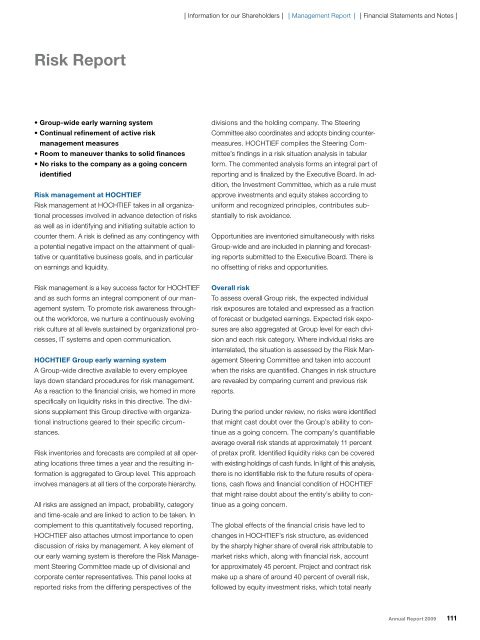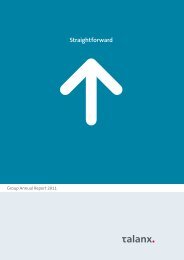ONE ROOF
ONE ROOF
ONE ROOF
Create successful ePaper yourself
Turn your PDF publications into a flip-book with our unique Google optimized e-Paper software.
Risk Report<br />
• Group-wide early warning system<br />
• Continual refinement of active risk<br />
management measures<br />
• Room to maneuver thanks to solid finances<br />
• No risks to the company as a going concern<br />
identified<br />
Risk management at HOCHTIEF<br />
Risk management at HOCHTIEF takes in all organizational<br />
processes involved in advance detection of risks<br />
as well as in identifying and initiating suitable action to<br />
counter them. A risk is defined as any contingency with<br />
a potential negative impact on the attainment of qualitative<br />
or quantitative business goals, and in particular<br />
on earnings and liquidity.<br />
Risk management is a key success factor for HOCHTIEF<br />
and as such forms an integral component of our management<br />
system. To promote risk awareness throughout<br />
the workforce, we nurture a continuously evolving<br />
risk culture at all levels sustained by organizational processes,<br />
IT systems and open communication.<br />
HOCHTIEF Group early warning system<br />
A Group-wide directive available to every employee<br />
lays down standard procedures for risk management.<br />
As a reaction to the financial crisis, we homed in more<br />
specifically on liquidity risks in this directive. The divisions<br />
supplement this Group directive with organizational<br />
instructions geared to their specific circumstances.<br />
Risk inventories and forecasts are compiled at all oper-<br />
ating locations three times a year and the resulting in-<br />
formation is aggregated to Group level. This approach<br />
involves managers at all tiers of the corporate hierarchy.<br />
All risks are assigned an impact, probability, category<br />
and time-scale and are linked to action to be taken. In<br />
complement to this quantitatively focused reporting,<br />
HOCHTIEF also attaches utmost importance to open<br />
discussion of risks by management. A key element of<br />
our early warning system is therefore the Risk Management<br />
Steering Committee made up of divisional and<br />
corporate center representatives. This panel looks at<br />
reported risks from the differing perspectives of the<br />
❘ Information for our Shareholders ❘ ❘ Management Report ❘ ❘ Financial Statements and Notes ❘<br />
divisions and the holding company. The Steering<br />
Committee also coordinates and adopts binding counter-<br />
measures. HOCHTIEF compiles the Steering Com-<br />
mittee’s findings in a risk situation analysis in tabular<br />
form. The commented analysis forms an integral part of<br />
reporting and is finalized by the Executive Board. In addition,<br />
the Investment Committee, which as a rule must<br />
approve investments and equity stakes according to<br />
uniform and recognized principles, contributes substantially<br />
to risk avoidance.<br />
Opportunities are inventoried simultaneously with risks<br />
Group-wide and are included in planning and forecasting<br />
reports submitted to the Executive Board. There is<br />
no offsetting of risks and opportunities.<br />
Overall risk<br />
To assess overall Group risk, the expected individual<br />
risk exposures are totaled and expressed as a fraction<br />
of forecast or budgeted earnings. Expected risk exposures<br />
are also aggregated at Group level for each division<br />
and each risk category. Where individual risks are<br />
interrelated, the situation is assessed by the Risk Management<br />
Steering Committee and taken into account<br />
when the risks are quantified. Changes in risk structure<br />
are revealed by comparing current and previous risk<br />
reports.<br />
During the period under review, no risks were identified<br />
that might cast doubt over the Group’s ability to continue<br />
as a going concern. The company’s quantifiable<br />
average overall risk stands at approximately 11 percent<br />
of pretax profit. Identified liquidity risks can be covered<br />
with existing holdings of cash funds. In light of this analysis,<br />
there is no identifiable risk to the future results of operations,<br />
cash flows and financial condition of HOCHTIEF<br />
that might raise doubt about the entity’s ability to continue<br />
as a going concern.<br />
The global effects of the financial crisis have led to<br />
changes in HOCHTIEF’s risk structure, as evidenced<br />
by the sharply higher share of overall risk attributable to<br />
market risks which, along with financial risk, account<br />
for approximately 45 percent. Project and contract risk<br />
make up a share of around 40 percent of overall risk,<br />
followed by equity investment risks, which total nearly<br />
Annual Report 2009 111
















